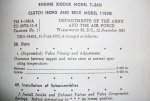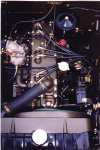I am not here to say which valve clearance is best, or safest, or appropriate. But Having spent 30 years in the army, from '69 on, I have some awareness of the military having to "work with what they have" in personnel. I am pretty sure the American trooper of today is surely far more educated than the "average" soldier of those days. In my infantry platoon in '69, the education level of my troops ranged from 10th grade draftee to college graduates. Back in those days, the inductee who could type and handle office responsibilities were "siphoned-off" before they got down to a leg infantry unit. And while our company mechanics were talented and experienced, they too had to work with troops and drivers pulling first echelon maintenance, and trying to repair our M113's. M37's were leaving the active army when I started my own career, so I had no experience with them.
But if he army was experiencing burned valves because of the difficulty and hazards of adjusting hot side valve engines, and hence went to "change-1" for a substantially greater clearance, perhaps part of the reason was due to inexperienced troops trying to accomplish a complex and hazardous task under sometimes arduous conditions with demanding commanders who wanted as many vehicles duty ready, with limited access to the proper tools. So maybe better too much clearance than too little.
In other words, the reason for the larger clearance may not have been strictly for longer, more efficient engine life. If an engine runs better with a larger or smaller tappet clearance, it may be due to the unique characteristics of each motor.
I found it time consuming to precisely set my own clearances with my motor turned on its side on an engine stand. I can't imagine trying to it with the motor in the truck, much less hot and running.
all the best..
NV




